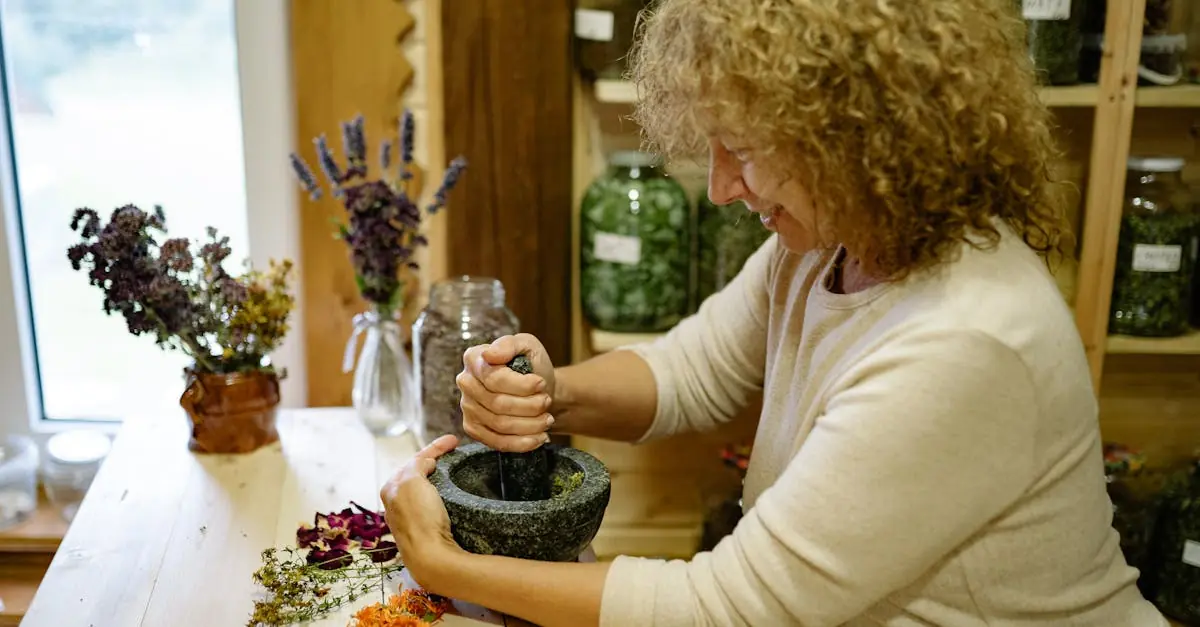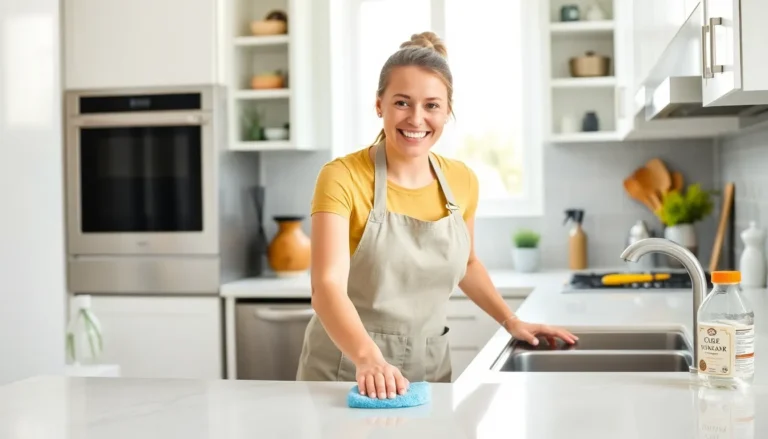Transforming a kitchen doesn’t have to mean a complete overhaul. With DIY cabinet refacing, it’s like giving your kitchen a facelift without the hefty price tag. Who knew that a little paint and some new hardware could turn those tired cabinets into the stars of the show?
Table of Contents
ToggleOverview of DIY Refacing Kitchen Cabinets
DIY refacing kitchen cabinets offers a practical and budget-friendly approach to updating a kitchen. This process enables homeowners to achieve a refreshed look without extensive renovations.
Benefits of Refacing Cabinets
Refacing cabinets enhances the kitchen’s appearance while maintaining existing structures. Homeowners enjoy improved aesthetics through fresh finishes and modern hardware. Increased property value often follows, especially when kitchens appear updated and inviting. Time savings represent another major advantage, as DIY refacing typically takes less time than a full remodel. This approach also minimizes waste by reusing existing cabinet boxes, contributing to environmental sustainability.
Cost Considerations
Cost considerations play a crucial role in DIY cabinet refacing. Savings can accumulate quickly, usually ranging from 30% to 50% compared to complete replacement. Material choices significantly influence expenses, with laminate and veneer options generally being more affordable than solid wood. Labor costs diminish when homeowners take on the project themselves, further reducing the total expenditure. It’s essential to budget for tools and materials, as these can add up. Understanding these costs upfront helps in planning a successful cabinet refacing project.
Tools and Materials Needed
For a successful DIY kitchen cabinet refacing project, having the right tools and materials is crucial. These items ensure a smooth process and high-quality results.
Essential Tools for the Job
- Screwdriver: A reliable screwdriver helps with removing cabinet doors and hardware.
- Drill: An electric drill is necessary for driving screws and making pilot holes.
- Paintbrush: A quality paintbrush applies paint evenly on cabinet surfaces.
- Roller: A roller covers larger areas efficiently and minimizes texture variations.
- Sanding block: A sanding block smooths surfaces for better paint adhesion.
- Measuring tape: Accurate measurements prevent errors in cutting materials.
Recommended Materials
- Cabinet veneer: Self-adhesive veneer transforms cabinet faces with a durable finish.
- Paint: Select high-quality paint for a long-lasting and attractive look.
- Primer: Using primer enhances paint adhesion and coverage.
- New hardware: Choosing stylish knobs and pulls updates the overall aesthetic.
- Wood filler: Wood filler repairs dents and scratches before painting.
- Caulk: Caulk seals gaps and provides a finished look around cabinets.
Step-by-Step Guide to DIY Refacing
Refacing kitchen cabinets requires careful planning and execution. This section outlines the essential steps for achieving a successful transformation.
Preparation and Planning
Start by assessing the current state of the cabinets. Consider the color scheme and style you want to achieve in the kitchen. Measure each cabinet carefully to determine how much veneer or paint is needed. Create a list of required materials and tools, focusing on high-quality options. Budgeting for both materials and unexpected costs contributes to smoother project management. Sketching a layout of the kitchen helps visualize the final look. Planning the timeline ensures adequate time for each step, avoiding rushed decisions.
Removing Old Cabinet Doors and Hardware
Begin with removing all cabinet doors and drawer fronts. Unscrew hinges carefully, keeping them organized for easy reinstallation. Detach drawer pulls and knobs to avoid damage during the refacing process. Place removed hardware in labeled bags to maintain organization. Once the doors and hardware are off, clean the cabinet boxes thoroughly to prepare for refinishing. Cleaning ensures proper adhesion of new finishes. Next, address any repairs needed on cabinet surfaces, such as filling holes or scratches with wood filler.
Applying Veneer or New Finishes
Applying cabinet veneer requires precision and care. Start by cutting the veneer sheets to fit each door. Use a roller to apply adhesive evenly before pressing the veneer onto the surface. Ensuring there are no bubbles or wrinkles is crucial for a smooth finish. For those opting to use paint, choose a primer that suits the cabinet surface for better adhesion. Apply the first coat of paint evenly using a brush or roller, allowing ample drying time. After the first coat dries, lightly sand the surface before applying a second coat for a polished look. Finish with new hardware to enhance the overall style of the cabinets.
Tips for a Professional Finish
Achieving a professional finish during DIY cabinet refacing enhances aesthetics and durability. Attention to detail and skillful techniques yield remarkable results.
Techniques for Smooth Application
Start with proper surface preparation; this ensures paint or veneer adheres effectively. Sand surfaces thoroughly to eliminate imperfections, creating an ideal canvas. Using high-quality brushes or rollers minimizes streaks and inconsistencies in the finish. Apply multiple thin coats rather than one thick layer; this promotes even coverage and reduces drips. Allow each coat to dry completely before proceeding; patience ensures durability and a polished look.
Choosing the Right Color and Style
Selecting an appropriate color involves considering the overall kitchen design. Neutral tones provide versatility and allow flexibility for future decor changes. Bold colors can make cabinets a stunning focal point but require careful coordination with adjacent elements. Styles should complement the home’s architectural design; classic cabinets suit traditional settings while sleek finishes align with modern interiors. Sampling colors on small sections helps visualize the outcome before committing to larger applications.
Common Mistakes to Avoid
Homeowners often encounter various challenges when refacing kitchen cabinets. Being aware of these common mistakes can lead to a more successful DIY project.
Overlooking Measurements
Accurate measurements are crucial for a seamless cabinet refacing. Neglecting to measure properly can result in mismatched veneers or ill-fitting doors. Before purchasing materials, measure each cabinet individually to account for variations. It’s wise to double-check dimensions, as a minor error can disrupt the entire process. Use a reliable measuring tape and document all measurements in one place to avoid confusion. Purchasing excess material can provide a safety net for any mistakes.
Skimping on Quality Materials
Choosing quality materials significantly influences the outcome of the project. Using inferior products can lead to premature wear and diminish the finished look. High-quality cabinet veneer and paint ensure durability and a polished appearance. Sourcing strong hardware also enhances cabinet functionality. Investing upfront in better materials eliminates the need for repairs or replacements in the future. It’s important to prioritize materials that withstand kitchen conditions, including humidity and temperature fluctuations. Reliable brands often yield better results and long-lasting satisfaction.
DIY cabinet refacing offers an exciting opportunity to breathe new life into a kitchen without breaking the bank. With careful planning and the right materials, homeowners can achieve stunning results that elevate their space. The process not only enhances the kitchen’s aesthetics but also contributes to increased property value and sustainability.
By focusing on quality and precision, individuals can avoid common pitfalls and ensure a professional finish. Embracing this project empowers homeowners to showcase their creativity while enjoying the satisfaction of a job well done. Ultimately, DIY cabinet refacing is a rewarding venture that transforms not just cabinets but the entire kitchen experience.




